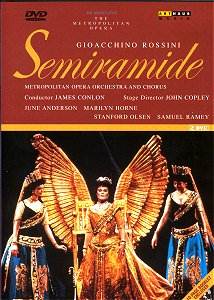You've got to hand it to the Met. If you are going
to mount a performance of Rossini's final Italian blockbuster then there
is only one way to do it, and that is properly. That means investing
in lavish sets and costumes, arranging them in grand, tableau-esque
public scenes to show them to best advantage, and gathering a cast that
can cope with the hair-raising vocal demands that Rossini (and his Venetian
audience) expected from professional singers schooled in the bel canto
style of the period. It also needs a conductor who can navigate with
a sure pace through what is a very large musical landscape.
Stage director John Copley and his designer clearly
had the budget to do what is required and they are served by a rare
breed of singers who can convincingly carry off that combination of
lyricism and virtuoso coloratura that is the bel canto style. After
Semiramide, when Rossini went to Paris, he wrote new operas
(and adapted some old ones) to cater for the taste for grand opera in
the French manner. This meant dropping some of the Italianisms that
suffuse Semiramide, including the florid vocalising and the habit
of writing main male parts to be sung by women, a hangover from Italian
castrato practice. Yet Semiramide clearly shows how some
French Grand Opera practice had crept into Italy, especially in Venice,
and the result is a grand opera that is Rossini’s final and finest celebration
of bel canto.
There have been a number of reasons offered as to why
this masterpiece dropped out of the repertoire not long after its initial
success (although there was a performance at the Met in 1894). One of
them is that the kind of bel canto mezzo-soprano required to play Arsace,
the male lead, had virtually died out by the second half of the
nineteenth century. The opera’s 20th century post war resurrection depended
on a revival of the breed and here we have the magnificent Marilyn Horne
who has made a major contribution to the return of some of Rossini’s
forgotten masterpieces to the repertoire. This recording is over a decade
old now, yet even then Marilyn Horne seemed to have been around a very
long time. My initial encounter with her voice was on one of the first
LPs I ever heard, dubbing Dorothy Dandridge in Carmen Jones,
the black musical version of Carmen in the mid-fifties. Her teaming
up with Joan Sutherland in Semiramide in the sixties provided
one of the great vocal feasts of the decade and the Decca recording
of 1966, in spite of all that Donizetti, was probably the finest thing
that Sutherland and conductor husband, Richard Bonynge, ever did together.
It set a benchmark that was not endangered by the recording made nearly
thirty years later by DG with Cheryl Studer and Jennifer Larmore under
an erratic Ion Marin. This DVD though provides a worthy competitor to
the Bonynge.
Marilyn Horne’s Semiramide is June Anderson who is
well capable of handling the vertiginous coloratura although she’s not
quite La Stupenda – but then who is. Neither of
them could be accused of putting too much effort into the acting side
but to be fair, their rather static approach to things is a production
issue and what they do is in keeping with the overall tableau approach
designed for the vastness of the Met. This does become a disadvantage
for DVD because when the camera homes in on, for example, an intimate
duet, we are invading a space in a way that is not possible for most
of the audience.
One of the great strengths of the production is its
sense of homogeneity, especially on the musical side. A strong feeling
teamwork persists which may have something to do with this world class
performance being an all American affair from conductor through orchestra,
chorus and cast. The result is an accuracy of ensemble that often borders
on, and reaches, perfection. A well known example is Serbami ognor,
the extended duet between Semiramide and Arsace made famous by Sutherland
and Horne in extracted form. The first section of it is taken significantly
slower by Conlon compared with Horne’s version with Bonynge, but conductor,
orchestra and soloists are absolutely at one in the rendering. Perfection.
This DVD at last provides a worthy successor to the
Decca/Bonynge version in musical terms. Both sound and vision are good
and although there is nothing else on the two discs, there is an informative
booklet.
John Leeman


